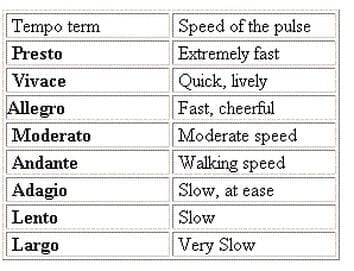Are you are musician or musical creative and looking for an article that discusses the tempo terms in music? Well, you have come to the right place.
What Is Tempo In Music?
Tempo in music is the speed or pace of a song. It is measured in beats per minute (BPM). Tempo is an essential element of music because it sets the mood and energy of the song. It can make a song sound upbeat, energetic, or slow and mellow.
Tempo also affects how the listener perceives the song, as it can make it sound faster or slower than it actually is. As such, tempo is a powerful tool for creating different atmospheres and emotions in a song.
Generally, a slower tempo will have a lower BPM and a faster tempo will have a higher BPM.
Tempo is an important element of music because it helps to set the mood and atmosphere of a piece of music. It also helps to create a sense of unity and cohesion between different sections of a song or piece of music. Tempo can also help to create a sense of tension or excitement, depending on how it is used. Finally, tempo helps to create a sense of rhythm and movement, which can be essential for keeping the listener engaged.
Tempo Markings In Music
Tempo markings are symbols used in musical notation to indicate the speed at which a piece of music should be played. The most common tempo markings are Italian words that indicate the speed of the piece in beats per minute (BPM).
These include:
Largo – very slow (40-60 BPM)
Adagio – slow (66-76 BPM)
Andante – moderate (76-108 BPM)]
Moderato – moderately (108-120 BPM)
Allegro – fast (120-168 BPM)
Presto – very fast (168-200 BPM)
Tempo markings can also be indicated by a metronome marking. A metronome is a device used for keeping time in music. It produces a regular, pulsing sound that can be used to help musicians keep a steady tempo while playing.
Tempo markings are important because they help the musician maintain a consistent speed throughout a piece of music. They also help to create the mood and feeling of a piece of music. For example, a piece of music marked Allegro will be played in a lively and upbeat manner, while a piece marked Adagio will be played in a slow and relaxed manner.
What Is A Time Signature?
A time signature is a notational convention used in Western musical notation to specify how many beats are in each measure and which note value is equivalent to one beat. It is usually written as a fraction, such as 4/4 or 3/4.
Making A Song Your Own Changing Tempo
You can make a song your own by changing the tempo by either speeding it up or slowing it down. You can also change the key of the song, add different instruments, or add vocal harmonies. Finally, you can also add your own lyrics or change the existing lyrics to make the song more personal.
Songs That Change Tempo Halfway Through
Elton John, Funeral For A Friend/Love Lies Bleeding, Goodbye Yellow Brick Road
Arcade Fire, Wake Up
Arcade Fire, Une Année Sans Lumiere
Arcade Fire, Crown of Love
Sufjan Stevens, Come on! Feel the Illinoise!, from Illinois
Boards of Canada, ’84 Pontiac Dream, The Campfire Headphase
Kate Bush, Sunset, Aerial
Closing Thoughts
The tempo of a piece helps keep a consistent rhythm and beat for the music being played. With a consistent tempo, musicians can create a cohesive sound that is easy to follow and enjoyable to listen to. Tempo also helps to create a sense of flow and energy in the music, which can make it more enjoyable for the listener. You can search for BPM to understand more by using the BPM Tapper tool on Music Gateway. Try it today.
For musicians and producers an online metronome tool is essential when recording, try Music Gateway’s online metronome tool here.











